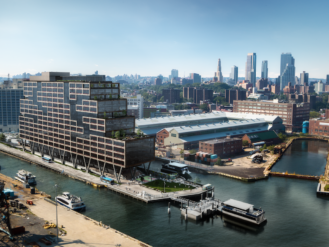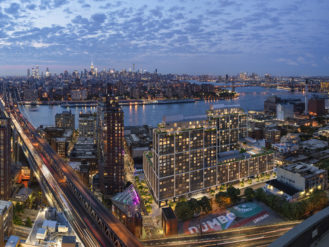Was a Fire Set to Destroy Part of Brooklyn’s Industrial Past?
A 19th century storehouse, damaged by a suspicious blaze, becomes a symbol of the struggle to preserve sites in Gowanus and Red Hook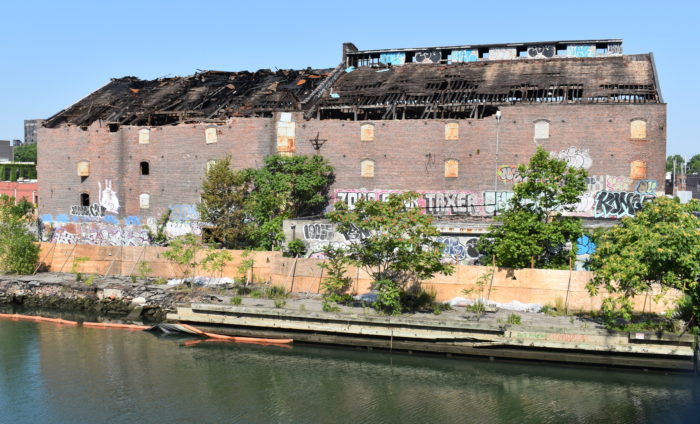
The Bowne storehouse on the Gowanus Canal, after the June fire (Photo by Steve Koepp)
The two-alarm fire that swept through a 19th-century Red Hook warehouse on the night of June 14 was a spectacle, complete with fireboats in the Gowanus Canal aiming multiple streams of water at the blaze. It sparked immediate controversy as well. The next day, City Council Member Carlos Menchaca, whose 38th District includes Red Hook, declared the fire “highly suspicious.”
Now, a month later, the city’s fire department (FDNY) has affirmed the elected official’s hunch. FDNY spokesman Jim Long told The Bridge this week that while the investigation is continuing, the event is now being “treated as a suspicious fire.” The FDNY’s current view was first reported by Crain’s New York Business.
The building is at the symbolic center of a conflict between the owner, who has petitioned to tear down the historic building, and neighborhood preservationists, who want to save notable examples of 19th-century industrial heritage, as the Red Hook and Gowanus neighborhoods are being transformed by residential construction.
What’s most inflammatory about this particular conflict is the timing of the fire. “It occurred after the Red Hook community raised alarms about recent, potentially illegal construction activity on the roof and after my office and community leaders took steps to start landmarking the building,” Menchaca said in his statement.

Fireboats on the Gowanus Canal battling the two-alarm fire last month (Photo by Anthony Laucerella/NYC Fire Wire)
The building, known as the S.W. Bowne Grain Storehouse, at 595-611 Smith St., was built of brick and wooden timbers in 1886. “At the time of its construction, the Bowne facility was a two-block complex used to process hay, feed, and grain for local stables, and its owner, S.W. Bowne, eventually became a wealthy man,” wrote photographer and preservationist Nathan Kensinger last year on Curbed. The company advertised its products as “Made A Little Better Than Seems Necessary.”
The building fell into disuse around 1960 and since then has become a deteriorating venue for graffiti artists, “a uniquely feral 1800s artifact that may also soon disappear,” Kensinger observed.
In fact, the building’s owners, the Chetrit Group, a Manhattan-based, family-owned development firm, wants to make that happen. The company applied to the city’s Department of Buildings last September to demolish the storehouse, but its request was denied because of incomplete paperwork, Brooklyn Paper reported. The company bought the property for $14.5 million in 2007.
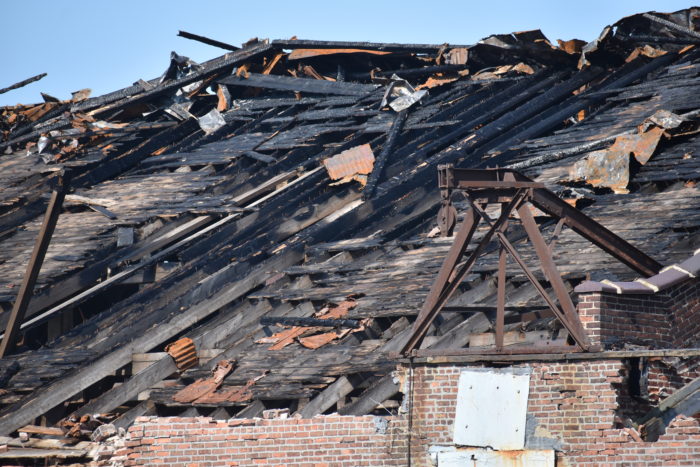
The fire left the building’s roof a charred skeleton (Photo by Steve Koepp)
In May, several preservation-minded groups calling itself the Gowanus Landmarking Coalition announced a list of nearly three dozen sites in the area for which they would be seeking landmark status. Their move comes as the city is taking steps to rezone the Gowanus neighborhood, in part to open up opportunities for residential development. While the S. W. Bowne Grain Storehouse is in a separate zoning area, the Southwest Brooklyn Industrial Business Zone, the building was on the coalition’s list of proposed landmarks. The same month, Gowanus coalition member Brad Vogel put in a request for the building to be evaluated by the Landmark Preservation Commission.
Around that time, Vogel saw someone on the building’s roof, hacking away with an ax, which he found ominous. Says Vogel: “As soon as you take the roof off, that means more damages.” Vogel says he called to alert the contracting company listed on a sidewalk shed on the property, Lakhi General Contractor of Syosset on Long Island, but never heard back. (Calls to the company by The Bridge were not immediately returned.) Other Brooklyn residents told Brownstoner that they had seen workers hauling timbers out of the building.
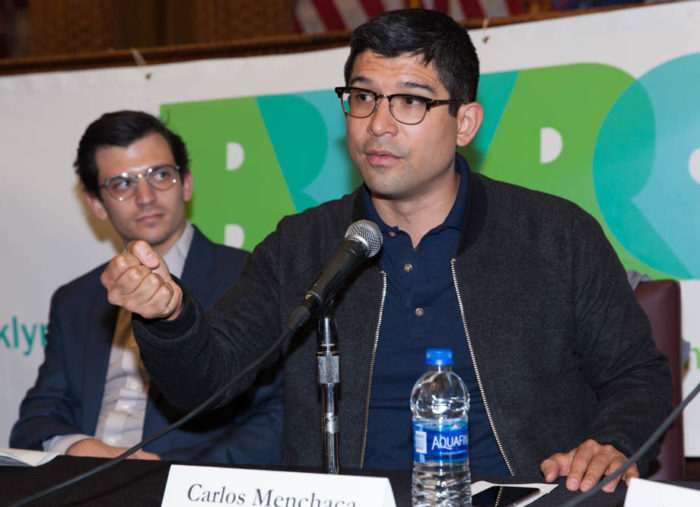
Council Member Menchaca, who called the fire “highly suspicious” the day after the blaze (Official NYC Council photo by William Alatriste)
The day before the fire, Vogel met with a staffer for Council Member Menchaca, asking for Menchaca’s support in getting approval for landmark protection for the building. The fire broke out at 11:15 the next night, leaving most of the roof a charred skeleton. Not a coincidence, say the preservationists. “As soon as there appears to be a hurdle to demolition plans, the fire happens,” says Vogel.
Menchaca’s statement the next day was a call to arms. “The Chetrit Group has willfully neglected [the property] and created a local nuisance for many years,” he said. “I also place the owners of this property on notice: I will not allow demolition by neglect or fire to prompt zoning changes that allow residential or other non-manufacturing uses at this site in Red Hook’s Industrial Business Zone.” Within a week of the fire, the Department of Buildings placed a stop-work order on the property after finding that illegal demolition had been taking place.

Developer Joseph Chetrit at a news conference in 2013 about the sale of buildings in Manhattan (Photo by Richard B. Levine/Newscom)
The Chetrit Group–controlled by Joseph Chetrit, three of his brothers and his father–has a reputation for stealthy dealings. Seven years ago, The Observer published a story titled “Joseph Chetrit, the Most Mysterious Big Shot in New York Real Estate.” The story, in which the family did not participate, describes the Chetrits as businessmen who “deal in the shadows, content to cultivate auras of savviness and even fear, emerging only reluctantly.”
In 2005, the Chetrit Group bought the neighboring Midtown Manhattan buildings 200 Fifth Avenue and 1107 Broadway for $355 million. Considered “the nexus of the American toy industry,” as The Observer noted, the buildings’ tenants included Hasbro and Mattel. A major toy fair took place there, annually drawing hundreds of buyers. “Mr. Chetrit ended all that,” the story said, as the developer put residential conversion plans in motion. “Dozens sued Mr. Chetrit, alleging harassment: toilet paper wasn’t replaced in the bathrooms; the A.C. was cut in the lobbies and hallways; a lot of the elevators were shut off.” Ultimately, the toy companies were ousted, and the Chetrit Group flipped the buildings in 2007 for $715 million.
The Bridge called the Chetrit Group’s office for comment several times since the fire, each time being told that the company’s managers were on vacation.
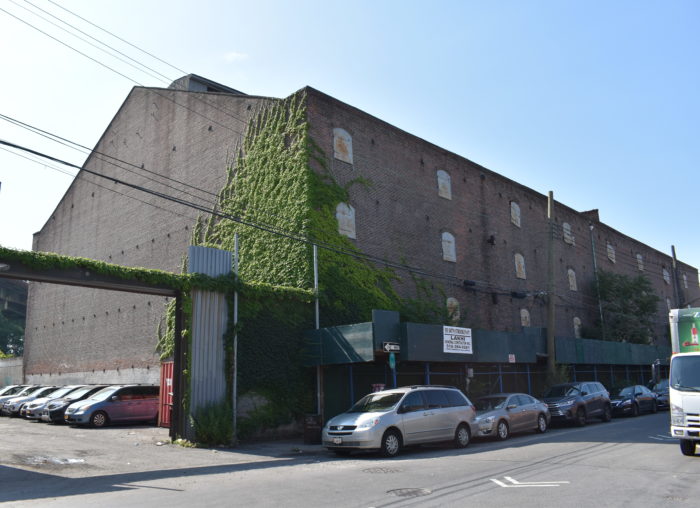
The brick building has a gabled roof, unusual for a warehouse of its era (Photo by Steve Koepp)
Since the fire, the Gowanus Landmarking Coalition launched a petition to landmark the old storehouse, describing it’s architectural significance: “Its unusual gable-ended design and roof is a departure from other storehouses, which were usually flat-roofed. Despite the fire, S.W. Bowne retains a high degree of architectural integrity, including its original fire shutters and star-ended tensile tile rods, and still visually reads as a 19th century industrial giant.” This week, after the FDNY’s disclosure, the coalition offered a $300 reward for information that leads to an arrest in connection with the fire. “I hope that justice is done in this instance. Period,” Vogel told The Bridge.
Arson plagued the city in the 1970s, with fires often sparked by building owners eager to collect insurance money from unoccupied structures. After a law-enforcement crackdown, advancements in arson-investigation science, and the rise of property values, the number of purposely set fires dropped substantially. Still, arson remains one of the most difficult crimes to prosecute because evidence–often destroyed in the event itself–is difficult to collect.
In the struggle over the preservation of the S.W. Bowne Grain Storehouse, the economic pressures may be even more challenging than the ravages of fire. “Like many of the buildings that are on the Gowanus Landmarking Coalition list, it’s still a vulnerable building that could be adapted and reused. Right now it’s vulnerable to development pressure,” says Kimberly Maier, a member of the coalition and the executive director of The Old Stone House, a reconstruction of a Dutch farmstead in Park Slope that played a role in the Battle of Brooklyn.
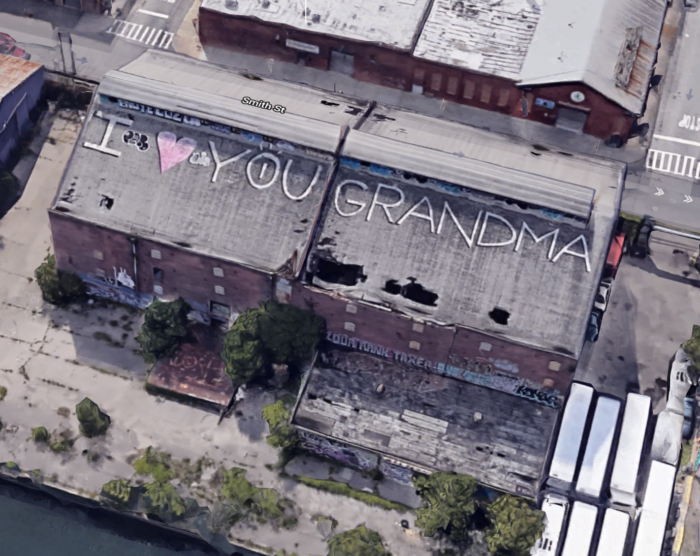
Before the fire, the roof was still largely intact–and a canvas for graffiti artists (Photo via Google Maps)
Maier calls the Bowne storehouse “an incredible building. It was built in a way that would allow it to withstand this kind of destruction,” she says. “We’d like to see it continue to be a part of this ongoing story of the Gowanus neighborhood.”
Thanks to the fire, the building has also become symbolic of the latest battle of Brooklyn, one about real-estate development. “The Bowne building is at the center of an enormous land grab, where wealthy real estate speculators are snatching up as much property as they can, in anticipation of being allowed to build new luxury residential towers and office buildings,” photojournalist Kensinger told The Bridge in an email. “If we want to preserve some aspect of the history of Brooklyn’s waterfront, we must do a better job of protecting these older buildings.”






